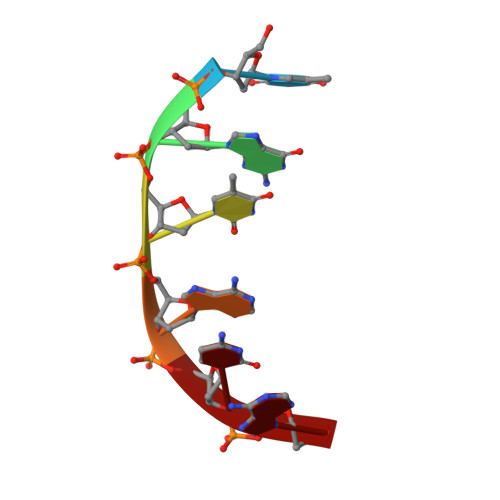Binding of two novel bisdaunorubicins to DNA studied by NMR spectroscopy.
Robinson, H., Priebe, W., Chaires, J.B., Wang, A.H.(1997) Biochemistry 36: 8663-8670
- PubMed: 9289011
- DOI: https://doi.org/10.1021/bi970842j
- Primary Citation of Related Structures:
1AL9, 1AMD - PubMed Abstract:
In the search for new generations of anthracycline drugs, lower cytotoxic side effects and higher activity against resistant cancer cells are two major goals. A new class of bis-intercalating anthracycline drugs has been designed, synthesized, and shown to have promising activity against multidrug-resistant cells. Two daunorubicins symmetrically linked together via a p-xylenyl group, either at their N3' (compound WP631) or N4' sites (compound WP652), exhibit extraordinary DNA binding affinities. We have used high-resolution NRM studies to understand the DNA binding mode of these two new bis-daunorubicin anticancer compounds. The structures of the WP631-d(ACGTACGT)2 and the WP652-d(TGTACA)2 complexes have been determined by NOE-restrained refinement. WP631 binds strongly to the 5'-CG(A/T)(A/T)CG hexanucleotide sequence, with the aglycons intercalated between the two CpG sites at both ends of the hexanucleotide sequence. The overall conformation of the WP631-d(CGTACG)2 part is remarkably similar to the crystal structure of the 2:1 complex of daunorubicin and d(CGTACG)2, as predicted previously [Gao, Y.-G., & Wang, A.H.H. (1996), J. Biomol. Struct. Dyn. 13, 103-117]. In contrast, the related bis-intercalator WP652 prefers the 5'-PyGTPu tetranucleotide sequence, with the aglycons intercalated between the PypG and TpPu sites. The binding of WP652 to DNA results in a severely distroted B-DNA duplex with the p-xylenyl tether moiety significantly protruded away from the bottom of the minor groove. While WP652 in some ways behaves similarly to other anticancer bis-intercalating antibiotics (e.g., triostine A and echinomycin), the detailed interactions between those two classes of bis-intercalators are quite different.
Organizational Affiliation:
Department of Cell & Structural Biology, University of Illinois at Urbana-Champaign, Urbana, IL 61801, USA.















